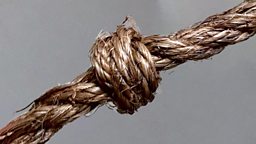Have you got your knots all wrong?
Did you know that knots are among the oldest human technologies? In Five Knots, Timandra Harkness unties a handful of them, and explores how they string together history, culture, forensics, life-saving and mathematics – and can even be examined to help solve crimes.

We were tying knots 9,000 years ago
Des Pawson, a professional rope worker and one of the world's leading authorities on knots, houses in a shed in his garden. He explains how humans have been tying things together for millennia.
-
![]()
Five Knots
Timandra Harkness unties five knots that string together history, culture, forensics, life-saving and maths.
Today, a cargo net might be made up of a series of knots known as a sheet bend. But we know the sheet bend goes back as far as 7,000 BC because an ancient piece of net – using the very same knot – was discovered preserved in a marsh between Russia and Finland.
Mankind, before the Stone Age, was really a String Age.Des Pawson, one of the world's leading authorities on knots.
Going back even further, the remains of a man thought to be 20,000 years old was uncovered in Russia with a necklace around his throat. Although there was no string left, the beads were present and correct. He must have done something to secure the two ends of twine and, presumably, he knotted them, says Des.
“Mankind, before the Stone Age, was really a String Age,” says the rope worker.

Real knots were once used to measure the speed of boats
Why do we talk about “knots” as the measure of a speed of a boat? Real knots are behind the expression, says Des.
Ancient mariners would throw the “log”, a triangular piece of wood, over the back of their ship and the attached rope, knotted at regular intervals, would run out from a reel for a set period of time.
From the number of knots that had gone out over the stern of the boat you could calculate the speed of travel.

What’s it like living on a boat?
Poet and journalist Michelle Madsen talks about living on a canal boat.
Knots can be used to solve crimes
Forensic knot expert Mike Lucas helps police to solve murders and other crimes where rope has been involved.

It all started 25 years ago with a murder in Bournemouth. The police knew who had committed the crime – they just couldn’t pin it on him. But they had the rope that was used, and Mike was able to relate the knotting to the guy who did the job.
Clues that point towards who tied a knot include which way a knot twists, whether it’s a conventional knot (either a yachtsman’s knot, a climber’s knot, or a fishing knot) and how well it’s tied, tight or slack. A knot can even provide some indication as to whether the culprit is left or right-handed.
In one instance, when there were many knots used, Mike went through the accused’s house to look at his pictures, and how he tied his bicycle up in the garage. And he was able to successfully reconcile knots in the house with those on the victim.

Why you've (probably) been tying your shoelaces wrong
How to tie your shoelaces so they won't come undone... according to mechanical engineers

There are 85 different ways to tie a tie
We’ve all heard of the Windsor knot but did you know there are in fact “85 Ways to Tie a Tie”?
Does the way we tie a tie say something about ourselves? It is said that tyrants tend to have the biggest tie knots. Look out for a Windsor knot or beyond…
Physicist Thomas Fink, who co-authored the book of the same name, explains how you wouldn’t want to wear all of the combinations in public, because many are particularly “wonky.” But on top of the four traditional methods of tying a tie, they found nine other wearable options. He explains too that the humble tie, connected in a loop, is an example of an “unknot” in a branch of mathematics called “knot theory.”
Does the way we tie a tie say something about ourselves? Thomas does think there is one trend that persists: “Tyrants tend to have the biggest tie knots. Like Windsor knot or beyond…”
In climbing, knots are the difference between life and death
Professional rock climber Dave Macleod lives near Ben Nevis, and spends his time attempting new climbing routes in Scotland and all over the world – the harder the better. He explains just how important knots are in his line of work, and how the lack of one almost lead to his death.
“Our most fundamental use of the knot is just attaching the rope to your climbing harness when you actually climb, and obviously that needs to be beyond question at all times,” says Dave. Most climbers use either the bowline or the figure-of-eight to tie into their harness and, although there’s no tangible difference between how the two function, he favours the figure-of-eight because it’s an easier knot to visually check. Get the knot wrong, and the consequences could be fatal.
-
![]()
Tips for overcoming fear from the world’s best free solo climber
How Alex Honnold beat fear and scaled El Capitan in Yosemite National Park without ropes.

For Dave, an accident that left him seriously injured could have been prevented with the use of a simple knot. On the day in question, he was climbing with a friend’s rope, not realising that it had been cut short. As a result, his climbing partner accidentally lowered him off the end of the rope. He went into freefall, ending up wrapped around a tree at the base of the crag. “If we’d known the rope was going to be too short, or was at risk of being too short, then I would have just tied a knot in the end of the rope,” says Dave. Almost any knot would have worked.
Ancient knots are being used on Mars
Not only is the knot the oldest form of human technology, but it’s now being used in space.
The knot is the oldest form of human technology.
Some of the earliest known knots can be found on Mars, where they are being used to tie the cabling on the NASA Mars Rovers.
“Isn’t that lovely to think,” says Des, “that if that had landed five thousand years ago, on our planet, a man might have understood what was going on with the cordage.”

Life on Mars, the search continues…
91�ȱ� Inside Science speaks to those who have explored life on Mars over the past 40 years.
More from Radio 4
-
![]()
Five Knots
Timandra Harkness unties five knots that string together history, culture, forensics, life-saving and maths.
-
![]()
91�ȱ� Ideas: Why you're tying your shoelaces all wrong
Maybe you should try the 'superior reef' knot. Or if you're feeling fancy, the stylish Berluti.
-
![]()
Can you tap into a natural sense of direction?
A look at the science and stories behind this fascinating phenomenon.
-
![]()
How pollen cracked these mysteries
The unlikely crime fighting friend from the natural world.





